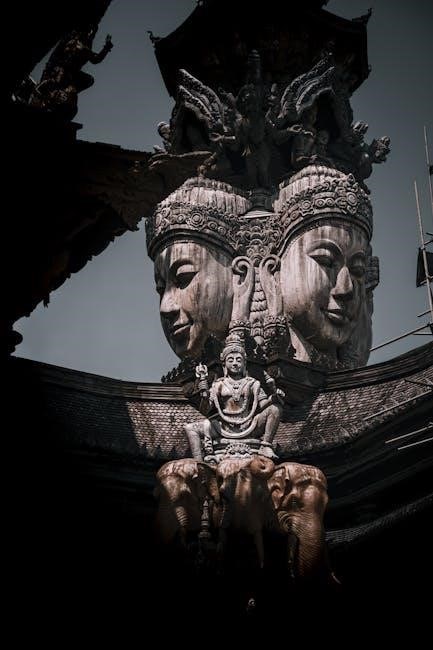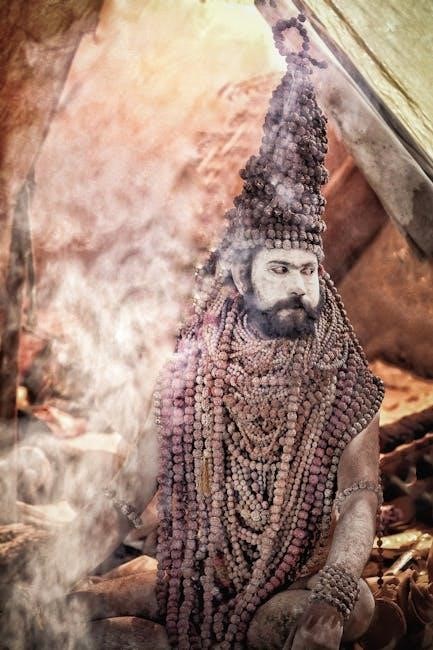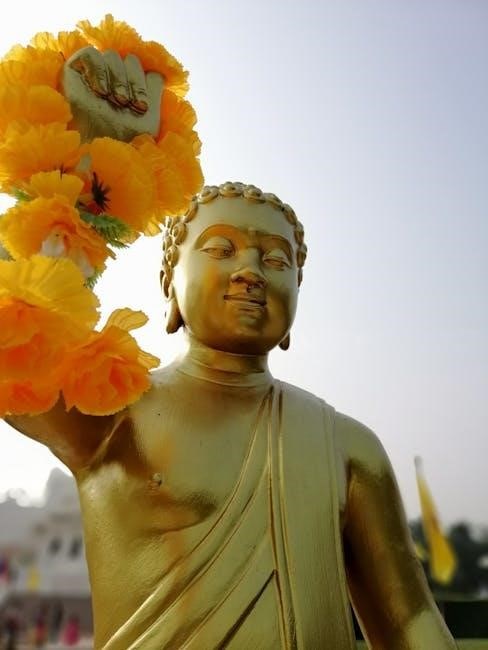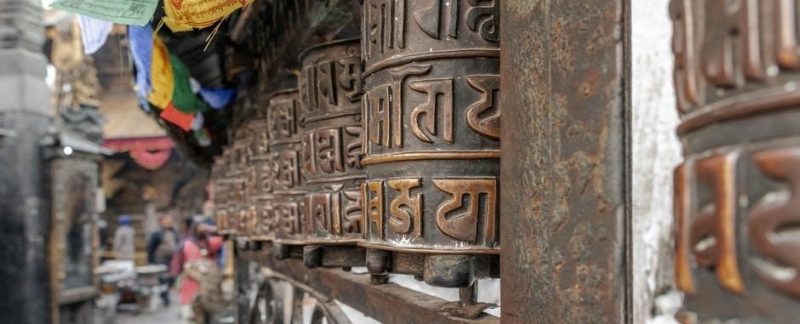The Argala Stotram is a revered Hindu devotional hymn dedicated to Goddess Durga, composed by the ancient sage Markandeya Rishi. It is a part of the Durga Saptashati, a significant text in Hindu scripture. This stotram consists of 27 powerful slokas written in Sanskrit, each imbued with spiritual significance and devotion. It is often recited by devotees to seek the blessings of Goddess Durga, who embodies strength and divine protection. The hymn is believed to help overcome life’s challenges and obstacles, offering solace and courage to those who chant it with faith. Its verses are melodic and profound, making it a popular choice for worship and meditation;
Background and Significance
The Argala Stotram holds a profound place in Hindu religious texts, particularly within the revered Durga Saptashati, a foundational scripture dedicated to Goddess Durga. Composed by the ancient sage Markandeya Rishi, this hymn is a testament to his deep devotion and spiritual wisdom. The stotram is not merely a literary composition but a sacred invocation that has been passed down through generations, cherished for its ability to connect devotees with the divine energy of Goddess Durga.


Historically, the Argala Stotram is deeply intertwined with the legend of Markandeya Rishi, a prominent figure in Hindu mythology known for his unwavering faith and spiritual prowess. According to legend, Markandeya composed this stotram as a means to impart spiritual knowledge to his disciples, emphasizing the importance of devotion and surrender to the divine feminine energy. The stotram is structured into 27 slokas, each meticulously crafted to evoke a specific emotional and spiritual response in the reciter. These verses are not only poetic but also carry profound philosophical insights, making them a cornerstone of Hindu worship and meditation.

The significance of the Argala Stotram lies in its ability to transcend mere worship and delve into the essence of spiritual growth. It is believed that reciting the stotram with devotion helps the seeker overcome life’s challenges, fostering courage and resilience. The hymn is particularly revered during the Navratri festival, a nine-day celebration honoring the nine forms of Goddess Durga. Devotees often recite the Argala Stotram during this period to seek blessings, prosperity, and protection from adversity.
Moreover, the Argala Stotram is considered a powerful tool for self-realization and inner transformation. Its verses are imbued with the energy of Goddess Durga, who embodies both nurturing compassion and fierce protection. By chanting the stotram, devotees believe they can align themselves with these divine qualities, fostering balance and harmony in their lives. The stotram’s significance is further amplified by its use in various rituals and ceremonies, where it is often recited to invoke the blessings of the goddess and create a sacred atmosphere of worship.

Structure and Composition
The Argala Stotram is a meticulously structured devotional hymn, comprising 27 verses or slokas, written in the sacred language of Sanskrit. This stotram is part of the broader text known as the Durga Saptashati, which is a cornerstone of Hindu devotional literature. The structure of the Argala Stotram is designed to evoke a deep sense of devotion and spiritual connection, making it a powerful tool for worship and meditation;

The hymn is divided into distinct sections, each serving a specific purpose in the worship of Goddess Durga. The opening verses set the tone by invoking the divine presence of the goddess, while the subsequent slokas delve into her divine attributes, her role as a protector, and her ability to dispel fear and adversity. The stotram also includes specific verses known as the Argala and Kilaka, which are believed to act as “locks” that bind the recitation together, enhancing its spiritual efficacy.
The language of the Argala Stotram is characterized by its poetic elegance and theological depth. Written in classical Sanskrit, the verses are rich in metaphor, simile, and symbolism, which not only add to their aesthetic appeal but also convey profound spiritual truths. The use of specific Sanskrit words and phrases ensures that the stotram retains its original intent and energy, making it a timeless piece of devotional literature.
The stotram follows a specific rhythm and meter, which are essential for its recitation. The verses are composed in a variety of meters, such as Anustup and Upajati, which are common in ancient Indian poetry. These meters not only enhance the musical quality of the recitation but also help in maintaining the focus and concentration of the devotee. The rhythm of the Argala Stotram is designed to create a meditative state, allowing the reciter to connect with the divine energy of Goddess Durga.

The composition of the Argala Stotram is deeply rooted in Hindu theology and philosophy. Each verse is carefully crafted to reflect the attributes of Goddess Durga, emphasizing her role as both a nurturing mother and a fierce protector. The stotram also draws upon themes of surrender, devotion, and the quest for spiritual liberation. By reciting the Argala Stotram, devotees are reminded of the importance of cultivating these qualities in their own lives.

One of the unique aspects of the Argala Stotram is its use of specific mantras and seed syllables, which are believed to carry immense spiritual power. These mantras are often repeated during the recitation, creating a sense of continuity and reinforcing the devotional intent. The stotram also includes verses that express gratitude and humility, highlighting the importance of these qualities in the pursuit of spiritual growth.
Importance in Hindu Worship
The Argala Stotram holds a significant place in Hindu worship, particularly among devotees of Goddess Durga, who is revered as the embodiment of divine strength, protection, and wisdom. This sacred hymn is considered a powerful tool for connecting with the goddess and seeking her blessings in times of adversity. Its importance lies in its ability to inspire devotion, provide solace, and empower individuals to face life’s challenges with courage and resilience.
One of the primary reasons for the Argala Stotram’s prominence in Hindu worship is its association with Goddess Durga, who is worshipped in various forms across India. The stotram is often recited during Navratri, a nine-day festival celebrating the divine feminine energy, as well as during other auspicious occasions. By chanting the Argala Stotram, devotees believe they can invoke Goddess Durga’s protective grace and seek her intervention in overcoming obstacles and hardships.

The stotram is also valued for its spiritual and emotional healing properties. Many believers turn to it during periods of personal crisis, seeking comfort and strength. The verses are imbued with a deep sense of surrender and devotion, which helps cultivate a mindset of humility and faith. This emotional connection with the divine is a cornerstone of Hindu worship, and the Argala Stotram serves as a potent medium for fostering such a relationship.
In addition to its devotional significance, the Argala Stotram is considered a potent means of spiritual growth. The stotram’s emphasis on the divine attributes of Goddess Durga encourages devotees to reflect on their own lives and strive for self-improvement; By internalizing the teachings of the stotram, individuals can cultivate qualities such as courage, compassion, and determination, which are essential for both personal and spiritual development.
The recitation of the Argala Stotram is also believed to bring about tangible benefits in one’s life. According to tradition, chanting the stotram with faith and dedication can lead to the fulfillment of desires, the removal of obstacles, and the attainment of prosperity. This belief is deeply rooted in Hindu spirituality, where the power of sound and mantra is considered a means of connecting with the divine and manifesting positive change in the world.
The stotram’s structure and composition further enhance its role in worship. The inclusion of specific sections such as the Argala and Kilaka verses adds to its spiritual potency, making it a comprehensive and effective devotional tool. These verses are often recited with meticulous attention to rhythm and tone, as the correct pronunciation and intonation are believed to amplify the stotram’s efficacy.

Moreover, the Argala Stotram is widely used in temple worship and community gatherings, fostering a sense of unity and shared devotion among participants. The collective recitation of the stotram creates a powerful spiritual atmosphere, where individuals can transcend their personal concerns and experience a deeper connection with the divine. This communal aspect of worship is a vital part of Hindu tradition, and the Argala Stotram plays a significant role in preserving and perpetuating this practice.
The Argala Stotram is a revered Hindu devotional hymn dedicated to Goddess Durga, a powerful incarnation of the divine feminine. This sacred text is an integral part of Hindu spirituality and is widely recited by devotees seeking divine grace, protection, and blessings. Composed by the ancient sage Markandeya Rishi, the Argala Stotram is a masterpiece of devotional poetry, imbued with deep spiritual significance and emotional resonance.
Structured as a series of 27 Sanskrit verses, the Argala Stotram is a segment of the broader text known as the Durga Saptashati, which is one of the most revered scriptures in Hinduism. The stotram is designed to invoke the blessings of Goddess Durga, who is worshipped as the embodiment of strength, wisdom, and divine protection. Its verses are rich in imagery and symbolism, describing the goddess’s various forms and attributes, while also expressing the devotee’s deep longing for spiritual connection and guidance.
The Argala Stotram is not merely a devotional text but also a powerful spiritual tool. Its verses are believed to possess the ability to dispel negativity, overcome obstacles, and bring about positive transformation in one’s life. Devotees often recite the stotram during times of personal crisis or challenge, seeking solace and strength in the divine energy of Goddess Durga. The stotram’s emphasis on surrender and faith makes it a deeply moving and uplifting experience for those who chant it with sincerity and devotion.
The stotram’s significance extends beyond its spiritual and devotional aspects. It is also celebrated for its literary and philosophical depth. The verses are composed in a melodious and rhythmic style, making them a joy to recite and listen to. At the same time, they convey profound insights into the nature of the divine and the human condition, encouraging reflection and introspection. This blend of artistry and spirituality has made the Argala Stotram a timeless classic, cherished by generations of devotees and scholars alike.
In modern times, the Argala Stotram has gained widespread accessibility through various formats, including printed books, digital PDF versions, and online recitations; This has allowed devotees from all over the world to engage with the text, regardless of their geographical or cultural background. The stotram’s universal themes of faith, resilience, and divine connection continue to resonate with people from diverse walks of life, making it a unifying force in Hindu spirituality.
For those seeking to deepen their understanding of Hindu devotional practices, the Argala Stotram serves as an excellent introduction to the rich tradition of stotra literature. Its accessibility, coupled with its profound spiritual content, makes it a valuable resource for both seasoned practitioners and newcomers alike. Whether recited in temples, homes, or personal spaces, the Argala Stotram remains a powerful medium for connecting with the divine and experiencing the transformative power of faith and devotion.
In essence, the Argala Stotram is more than just a hymn; it is a gateway to spiritual growth, emotional healing, and divine connection. Its enduring popularity is a testament to its timeless relevance and the profound impact it has on the lives of those who embrace it. For anyone exploring the depths of Hindu spirituality, the Argala Stotram offers a beautiful and inspiring journey into the heart of devotion and faith.
